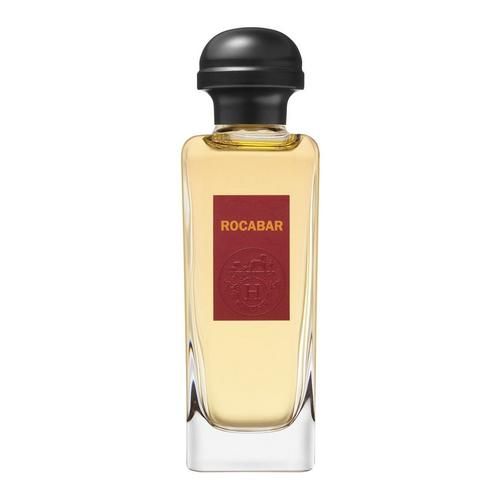Rocabar, the fiery and free fragrance of Hermès
In 1937, the brand designed the Hermès square, a 90 * 90 silk scarf which was immediately adopted by many celebrities. On the perfume side, Hermès entered the arena in 1951 with “Eau d’Hermès”. In 1998, Hermès unveiled a masculine fragrance with the somewhat bizarre name “Rocabar”.
Rocabar, the inseparable link between perfumery and horses
The horse world is the origin of the brand, and the latter wanted to pay homage to it here, for having given birth to it. This olfactory tribute will remain indelible as the link between the horse and perfumery. “Rocabar” refers to the prestigious brand saddlery workshops. In the 20th century, an English craftsman nicknamed the woolen blankets used to cover horses “Rugs with bars”. Hermès, then specialized in these equestrian accessories, gradually transformed the name into “rocabar”. Natural and warm, the horse wool blanket is deliciously in the spotlight, and through it, everyone from the horse. “Rocabar” is undoubtedly a warm and majestic fragrance that transports us to horizons that could not be more chivalrous.
The power of Rocabar’s olfactory notes
It is the nose Gilles Romey who imagined this fragrance in 1998. There is no doubt that it is inspired by a fiery and powerful horse, in love with freedom. “Rocabar” is a spicy woody flavor that is lively and warm. “Rocabar” opens with fresh and invigorating notes with bergamot and lemon. These are then joined by spices, mugwort and coriander which exude energy. The heart is majestic and made of noble woods such as Italian cypress, Atlas cedar, as well as violet flower and iris which give a lot of masculinity to the whole. The base is both sensual, soft, enveloping thanks to the presence of vanilla, benzoin, patchouli and oak moss. The first bottle was square and imposing. The rocabar cover tied with a leather tie then bound the glass bottle, itself wrapped in a link embedded in the mass of the glass. Its rifle-barrel stopper reminiscent of a polo helmet … Today, the bottle of “Rocabar” is one of the classic bottles of Hermès, inspired by the lanterns of the carriages of yesteryear. Having become an iconic Hermès bottle, these are all endowed with a sober and beautiful elegance.
Released in 1998, “Rocabar” is directly inspired by horses, mainly by their blanket. “Rocabar” is also an olfactory tribute to the beginnings of the brand, known mainly for its equestrian accessories. Between the world of perfumery and the horse, “Rocabar” presents itself as an unwavering link. A very powerful composition for a very fiery man.
Released in 1998, “ Rocabar ”has a direct link with the equestrian world, like most of the Hermès brand perfumes. “Rocabar” taken from “rug” which means blanket in English, is inspired by the blanket worn by horses, in blue and red stripes. If “Rocabar” is the perfect link between the world of horses and that of perfumery, it is nonetheless a tribute to the past. Remember that the founder of the brand, Thierry Hermès, was initially a saddler-harness.
Rocabar, a tribute to the beginning of the Hermès house
< p> When Thierry Hermès founded the Hermès house in 1837, he created products for horses, harnesses, blankets, straps and various equipment which he then sold in his Parisian boutique. 30 years after the opening of this boutique, the brand will be rewarded by receiving the “First Class” medal at the Universal Exhibition of 1867. From then on, the brand welcomes a more affluent clientele. Indeed, Tsar Nicolas II will come to equip his horses in the Hermès boutique. If Hermès has acquired letters of nobility, it is thanks to horses, and with “Rocabar”, Hermès wished to pay tribute to its beginnings, to Thierry Hermès who contributed to the enormous success of the brand. It is the perfumer Gilles Romey who is at the origin of the composition. To do this, he was inspired by a fiery and powerful horse, but more than anything, a horse loving freedom.
Rocabar and its extremely energetic scent notes
Gilles Romey has indeed created an energetic fragrance, both lively and intense. “Rocabar” begins with the lively notes of lemon and bergamot, enhanced by coriander and juniper berries. The first traces of lemon can be found 2,500 years ago in China and India. In the beginning, the lemon was a citron and it is possible that the current lemon came from a hybrid between the citron and the sour orange. The Romans and Egyptians used lemon for therapeutic purposes. In the 10th century, doctors prescribed lemon to fight fever. Today, lemon is one of the few citrus fruits, all parts of which are used. Rich in vitamin C, lemon is a very popular citrus fruit. In perfumery, lemon releases fresh, tangy and fruity tones. Then, the heart of “Rocabar” wants to be majestic and powerful, because it combines noble woods like the cedar of the Atlas, the cypress of Italy with flowers like the violet, the iris and the carnation, the whole. enhanced with cardamom. Atlas cedar is a magnificent evergreen conifer, up to 40 m tall. Atlas cedar essential oil has many virtues, especially for circulation disorders, cellulite and acne. In perfumery, cedarwood essence is obtained by steam distillation of sawdust from the tree. Atlas cedar gives off woody, camphoric and sweet scents. Then the base of “Rocabar” is extremely sensual and powerful and combines benzoin, patchouli, vanilla and oak moss.
Spicy New Freshness
